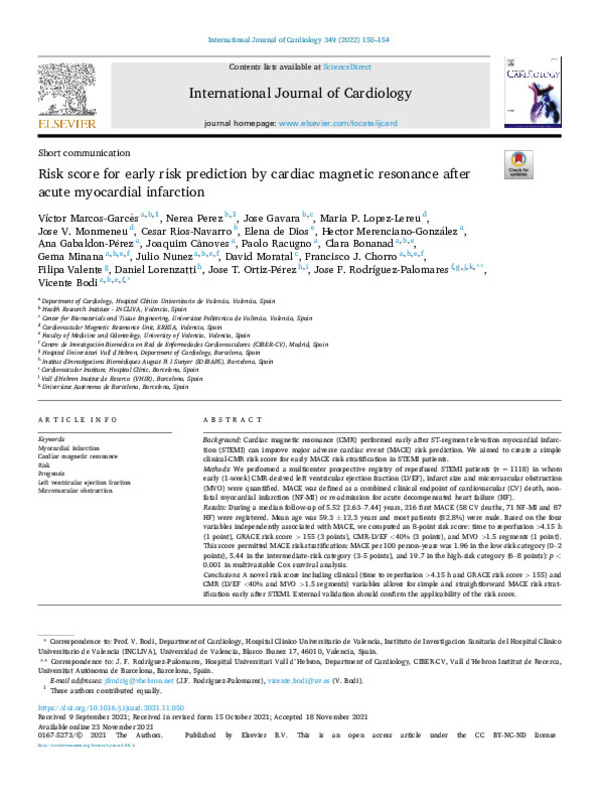Marcos-Garcés, V.; Perez, N.; Gavara-Doñate, J.; Lopez-Lereu, MP.; Monmeneu, JV.; Rios-Navarro, C.; De Dios, E.... (2022). Risk score for early risk prediction by cardiac magnetic resonance after acute myocardial infarction. International Journal of Cardiology. 349:150-154. https://doi.org/10.1016/j.ijcard.2021.11.050
Por favor, use este identificador para citar o enlazar este ítem: http://hdl.handle.net/10251/197363
|
Título:
|
Risk score for early risk prediction by cardiac magnetic resonance after acute myocardial infarction
|
|
Autor:
|
Marcos-Garcés, Víctor
Perez, Nerea

 Gavara-Doñate, Josep
Lopez-Lereu, Maria P.
Monmeneu, Jose V.
Rios-Navarro, Cesar
de Dios, Elena
Merenciano-González, Hector
Gabaldon-Perez, Ana
Cànoves, Joaquim
Racugno, Paolo
Bonanad, Clara
Miñana, Gema
Nunez, Julio
Gavara-Doñate, Josep
Lopez-Lereu, Maria P.
Monmeneu, Jose V.
Rios-Navarro, Cesar
de Dios, Elena
Merenciano-González, Hector
Gabaldon-Perez, Ana
Cànoves, Joaquim
Racugno, Paolo
Bonanad, Clara
Miñana, Gema
Nunez, Julio

 Moratal, David
Moratal, David
|
|
Entidad UPV:
|
Universitat Politècnica de València. Escuela Técnica Superior de Ingenieros Industriales - Escola Tècnica Superior d'Enginyers Industrials
|
|
Fecha difusión:
|
|
|
Resumen:
|
[EN] Background: Cardiac magnetic resonance (CMR) performed early after ST-segment elevation myocardial infarction (STEMI) can improve major adverse cardiac event (MACE) risk prediction. We aimed to create a simple ...[+]
[EN] Background: Cardiac magnetic resonance (CMR) performed early after ST-segment elevation myocardial infarction (STEMI) can improve major adverse cardiac event (MACE) risk prediction. We aimed to create a simple clinical-CMR risk score for early MACE risk stratification in STEMI patients. Methods: We performed a multicenter prospective registry of reperfused STEMI patients (n = 1118) in whom early (1-week) CMR-derived left ventricular ejection fraction (LVEF), infarct size and microvascular obstruction (MVO) were quantified. MACE was defined as a combined clinical endpoint of cardiovascular (CV) death, nonfatal myocardial infarction (NF-MI) or re-admission for acute decompensated heart failure (HF). Results: During a median follow-up of 5.52 [2.63-7.44] years, 216 first MACE (58 CV deaths, 71 NF-MI and 87 HF) were registered. Mean age was 59.3 +/- 12.3 years and most patients (82.8%) were male. Based on the four variables independently associated with MACE, we computed an 8-point risk score: time to reperfusion >4.15 h (1 point), GRACE risk score > 155 (3 points), CMR-LVEF <40% (3 points), and MVO >1.5 segments (1 point). This score permitted MACE risk stratification: MACE per 100 person-years was 1.96 in the low-risk category (0-2 points), 5.44 in the intermediate-risk category (3-5 points), and 19.7 in the high-risk category (6-8 points): p < 0.001 in multivariable Cox survival analysis. Conclusions: A novel risk score including clinical (time to reperfusion >4.15 h and GRACE risk score > 155) and CMR (LVEF <40% and MVO >1.5 segments) variables allows for simple and straightforward MACE risk stratification early after STEMI. External validation should confirm the applicability of the risk score.
[-]
|
|
Palabras clave:
|
Myocardial infarction
,
Cardiac magnetic resonance
,
Risk
,
Prognosis
,
Left ventricular ejection fraction
,
Microvascular obstruction Risk score
,
Acute myocardial infarction
|
|
Derechos de uso:
|
Reconocimiento - No comercial - Sin obra derivada (by-nc-nd)
|
|
Fuente:
|
International Journal of Cardiology. (issn:
0167-5273
)
|
|
DOI:
|
10.1016/j.ijcard.2021.11.050
|
|
Editorial:
|
Elsevier
|
|
Versión del editor:
|
https://doi.org/10.1016/j.ijcard.2021.11.050
|
|
Código del Proyecto:
|
info:eu-repo/grantAgreement/ISCIII/Plan Estatal de Investigación Científica y Técnica y de Innovación 2017-2020 (ISCIII)/PI20%2F00637/ES/RESOLUCION DE LA OBSTRUCCION MICROVASCULAR TRAS UN INFARTO DE MIOCARDIO: EVALUACION DE LAS CONSECUENCIAS ESTRUCTURALES Y CLINICAS Y BUSQUEDA DE NUEVAS OPCIONES TERAPEUTICAS./
...[+]
info:eu-repo/grantAgreement/ISCIII/Plan Estatal de Investigación Científica y Técnica y de Innovación 2017-2020 (ISCIII)/PI20%2F00637/ES/RESOLUCION DE LA OBSTRUCCION MICROVASCULAR TRAS UN INFARTO DE MIOCARDIO: EVALUACION DE LAS CONSECUENCIAS ESTRUCTURALES Y CLINICAS Y BUSQUEDA DE NUEVAS OPCIONES TERAPEUTICAS./
info:eu-repo/grantAgreement/Fundació La Marató de TV3//20153030-31-32/
info:eu-repo/grantAgreement/MINECO//CB16%2F11%2F00486/ES/ENFERMEDADES CARDIOVASCULARES/
info:eu-repo/grantAgreement/GVA//AEST%2F2020%2F029//Aplicación de técnicas de deep learning (aprendizaje profundo) para un análisis automático de imágenes de Resonancia/
info:eu-repo/grantAgreement/GVA//AEST%2F2019%2F037/
info:eu-repo/grantAgreement/Fundació Bancària Caixa d'Estalvis i Pensions de Barcelona//HR17-00527/
info:eu-repo/grantAgreement/Sociedad Española de Cardiología//SEC%2FFECINV-CLI 21%2F024/
info:eu-repo/grantAgreement/AEI//FJC2020-043981-I/
[-]
|
|
Agradecimientos:
|
This work was supported by the Instituto de Salud Carlos III and cofunded by Fondo Europeo de Desarrollo Regional (FEDER) (grants PI20/00637 and CIBERCV16/11/00486), "Marató TV3" [grant number 20153030-31-32], the Catalonian ...[+]
This work was supported by the Instituto de Salud Carlos III and cofunded by Fondo Europeo de Desarrollo Regional (FEDER) (grants PI20/00637 and CIBERCV16/11/00486), "Marató TV3" [grant number 20153030-31-32], the Catalonian Society of Cardiology 2015, La Caixa Foundation [HR17-00527], and by Sociedad Española de Cardiología (grant SEC/FECINV-CLI 21/024). D.M. acknowledges financial support from the Conselleria d'Educació, Investigació, Cultura i Esport, Generalitat Valenciana (grants AEST/ 2019/037 and AEST/2020/029). J. G. acknowledges financial support from the Agencia Estatal de Investigación (grant FJC2020-043981-I / AEI/10.13039/501100011033).
[-]
|
|
Tipo:
|
Artículo
|









